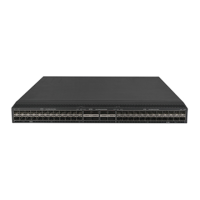38
Route interface: Not configured
Description: VLAN 0002
Name: VLAN 0002
Tagged ports: None
Untagged ports:
Twenty-FiveGigE1/0/2
Twenty-FiveGigE1/0/5
VLAN ID: 3
VLAN type: Static
Private VLAN type: Secondary
Route interface: Not configured
Description: VLAN 0003
Name: VLAN 0003
Tagged Ports: None
Untagged Ports:
Twenty-FiveGigE1/0/3
Twenty-FiveGigE1/0/5
The output shows that:
• The promiscuous port (Twenty-FiveGigE 1/0/5) is an untagged member of primary VLAN 5 and
secondary VLANs 2 and 3.
• Host port Twenty-FiveGigE 1/0/2 is an untagged member of primary VLAN 5 and secondary
VLAN 2.
• Host port Twenty-FiveGigE 1/0/3 is an untagged member of primary VLAN 5 and secondary
VLAN 3.
Example: Configuring trunk promiscuous ports
Network configuration
As shown in Figure 10, configure the private VLAN feature to meet the following requirements:
• VLANs 5 and 10 are primary VLANs on Device B. The uplink port (Twenty-FiveGigE 1/0/1) on
Device B permits the packets from VLANs 5 and 10 to pass through tagged.
• On Device B, downlink port Twenty-FiveGigE 1/0/2 permits secondary VLAN 2. Downlink port
Twenty-FiveGigE 1/0/3 permits secondary VLAN 3. Secondary VLANs 2 and 3 are associated
with primary VLAN 5.
• On Device B, downlink port Twenty-FiveGigE 1/0/4 permits secondary VLAN 6. Downlink port
Twenty-FiveGigE 1/0/5 permits secondary VLAN 8. Secondary VLANs 6 and 8 are associated
with primary VLAN 10.
• Device A is aware of only VLANs 5 and 10 on Device B.

